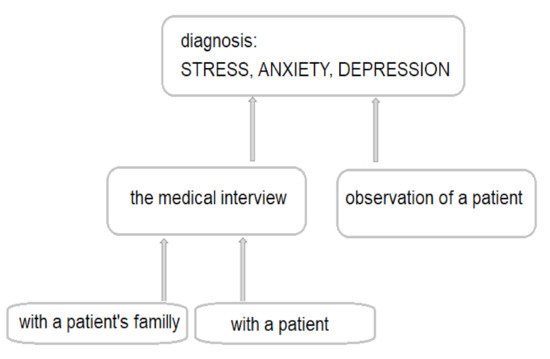For the past decade, more and more affective disorders have been diagnosed worldwide. Research reports suggest that depression is the second most common disease in the world after heart failure and may even take the lead in 2030 [
1,
2,
3]. Depressive disorders are very often preceded by the stress and accompanied by anxiety—the coexistence of anxiety and depression is found in nearly 75% of children and adolescents [
3,
4]. However, if anxiety and depressive disorders do not occur at the same time, they usually follow one another. It is estimated that the probability of anxiety disorders after a depressive episode is 47–58%, and 56% of patients with anxiety disorders develop depression [
5,
6,
7]. About 50% of depressive episodes are preceded by sudden, negative life events experienced by patients [
8,
9,
10,
11,
12]. Other factors predisposing to a depressive episode include chronic somatic diseases, including diabetes, multiple sclerosis, neoplastic diseases, myocardial infarction, stroke, obesity, etc. [
13]. In both of the above-mentioned cases, we deal with stressful situations. Experiencing stress definitely influences the emotional state of patients, as it initiates changes in the brain’s neurochemistry. Chronic stress causes a decrease in serotonin levels, changes in the density of serotonergic system receptors, an increase in glutamate levels and a decrease in the concentration of brain-derived neurotrophic factor (BDNF) [
14]. Unfortunately, stress is a phenomenon that occurs in everyone’s life. Additionally, most people feel anxious or even depressed from time to time. If the symptoms listed above are mild and pass in a relatively short time, they do not pose any major health risks. What is more, experiencing temporary stress is a positive reaction for the body, thanks to which processes that enable a person to properly cope with the challenges faced are triggered [
8,
14]. The actual anxiety or depressive disorders manifest themselves in a long-lasting, self-limiting intensification of experiencing negative emotions. Anxiety and depression definitely make it difficult for the patient to function in society. Over time, a patient with anxiety or depression loses their self-esteem and, subsequently, loses the motivation to take any life actions. Patients suffering from anxiety and/or depression suffer from problems with sleeping, appetite, psychomotor activity (agitation or impairment), dysregulation of the autonomic nervous system and digestive tract, sometimes even from psychosis, which can lead to thoughts and even attempted suicide. Anxiety and depression are complex disorders that have many subtypes and etiologies [
7,
9,
10,
15,
16]. Currently, in psychiatry, the main method used to diagnose stress, anxiety and/or depression are patient observation and medical interviews conducted with the patient and members of their immediate family (). In the diagnosis of depression and/or anxiety, additionally, the so-called diagnostic tests (e.g., Beck and Montgomery-Asberg in depression, Hamilton in depression and anxiety and Perceived Stress Scale) are used [
17,
18,
19]. The above-mentioned diagnostic tests are very valuable in the diagnosis of stress, anxiety and depression, but it would be better if they could complement the proper diagnosis or be used to assess the severity of the disorder or to observe the effectiveness of the therapy [
14]. The multitude of causes of stress, anxiety and depression, as well as the symptoms overlapping with those of other mental disorders, often make it difficult for psychiatrists to make an appropriate diagnosis and apply effective treatment. There are no specific laboratory tests that would be helpful in the diagnosis of anxiety and depression.
Therefore, this study will review salivary biomarkers that may be helpful in the diagnosis of stress, anxiety and depression. We chose saliva because in our opinion saliva is an ideal biological fluid for diagnostic, because it does not coagulate, it is stable for 24 h at room temperature and for a week at 4 °C. The use of saliva in medical diagnostics is becoming more and more popular; it is cheap, non-invasive, painless and convenient for both young children and the elderly. Saliva can be collected at the patient’s home and transported to the laboratory without the involvement of any medical personnel [
20,
21]. Saliva contains many substances, the concentration of which reflects the health of the whole organism, which can be used in easy and quick detection of early pathological changes in humans [
22,
23,
24,
25]. Saliva components can be cheaply determined using specific and sensitive immunological and/or biochemical methods, such as radioimmunoassay (RIA), enzyme-linked immunosorbent assay (ELISA), spectrophotometry or chromatography [
26,
27].
Despite the advantages of saliva, which we have listed above, we are aware that saliva is not an ideal biological material. The individual composition of saliva can be influenced by many factors, such as age, sex, smoking, diet, medications or the pathophysiological condition of the oral cavity. There are also other biological materials that are also non-invasive and cheap to obtain, such as hair, but they also have some disadvantages, as the composition of the hair can be highly adulterated with hair dyes or other cosmetics used for daily care [
28].

